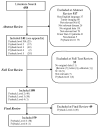Systematic review of CT and MR perfusion imaging for assessment of acute cerebrovascular disease
- PMID: 18583410
- PMCID: PMC8119039
- DOI: 10.3174/ajnr.A1161
Systematic review of CT and MR perfusion imaging for assessment of acute cerebrovascular disease
Abstract
Background and purpose: Perfusion imaging sequences are an important part of imaging studies designed to provide information to guide therapy for treatment of cerebrovascular disease. The purpose of this study was to perform a meta-analysis of the medical literature on perfusion imaging to determine its role in clinical decision making for patients with acute cerebral ischemia.
Materials and methods: We searched MEDLINE by using a strategy that combined terms related to perfusion imaging with terms related to acute cerebral ischemia and brain tumors. We identified 658 perfusion imaging articles and classified them according to the clinical usefulness criteria of Thornbury and Fryback. We found 59 articles with promise of indicating usefulness in clinical decision making. We devised and implemented a clinical decision making scoring scale more appropriate to the topic of acute cerebral ischemia.
Results: Several articles provided important insights into the physiologic processes underlying acute cerebral ischemia by correlation of initial perfusion imaging deficits with clinical outcome or ultimate size of the infarct. However, most articles showed relatively low relevance to influencing decisions in implementing treatment.
Conclusion: Most perfusion imaging articles are oriented toward important topics such as optimization of imaging parameters, determination of ischemia penumbra, and prediction of outcome. However, information as to the role of perfusion imaging in clinical decision making is lacking. Studies are needed to demonstrate that use of perfusion imaging changes outcome of patients with acute cerebral ischemia.
Figures
Similar articles
-
Magnetic resonance perfusion for differentiating low-grade from high-grade gliomas at first presentation.Cochrane Database Syst Rev. 2018 Jan 22;1(1):CD011551. doi: 10.1002/14651858.CD011551.pub2. Cochrane Database Syst Rev. 2018. PMID: 29357120 Free PMC article.
-
Systemic pharmacological treatments for chronic plaque psoriasis: a network meta-analysis.Cochrane Database Syst Rev. 2021 Apr 19;4(4):CD011535. doi: 10.1002/14651858.CD011535.pub4. Cochrane Database Syst Rev. 2021. Update in: Cochrane Database Syst Rev. 2022 May 23;5:CD011535. doi: 10.1002/14651858.CD011535.pub5. PMID: 33871055 Free PMC article. Updated.
-
Drugs for preventing postoperative nausea and vomiting in adults after general anaesthesia: a network meta-analysis.Cochrane Database Syst Rev. 2020 Oct 19;10(10):CD012859. doi: 10.1002/14651858.CD012859.pub2. Cochrane Database Syst Rev. 2020. PMID: 33075160 Free PMC article.
-
Cost-effectiveness of using prognostic information to select women with breast cancer for adjuvant systemic therapy.Health Technol Assess. 2006 Sep;10(34):iii-iv, ix-xi, 1-204. doi: 10.3310/hta10340. Health Technol Assess. 2006. PMID: 16959170
-
Measures implemented in the school setting to contain the COVID-19 pandemic.Cochrane Database Syst Rev. 2022 Jan 17;1(1):CD015029. doi: 10.1002/14651858.CD015029. Cochrane Database Syst Rev. 2022. Update in: Cochrane Database Syst Rev. 2024 May 2;5:CD015029. doi: 10.1002/14651858.CD015029.pub2. PMID: 35037252 Free PMC article. Updated.
Cited by
-
Value of sildenafil treatment for the prevention of vasospasm‑related delayed ischemic neurological deficits and delayed brain infarction following aneurysmal subarachnoid hemorrhage.Med Int (Lond). 2023 Mar 20;3(2):19. doi: 10.3892/mi.2023.79. eCollection 2023 Mar-Apr. Med Int (Lond). 2023. PMID: 37032716 Free PMC article.
-
Imaging-based treatment selection for intravenous and intra-arterial stroke therapies: a comprehensive review.Expert Rev Cardiovasc Ther. 2011 Jul;9(7):857-76. doi: 10.1586/erc.11.56. Expert Rev Cardiovasc Ther. 2011. PMID: 21809968 Free PMC article. Review.
-
Functional-Optical Coherence Tomography: A Non-invasive Approach to Assess the Sympathetic Nervous System and Intrinsic Vascular Regulation.Front Physiol. 2019 Sep 12;10:1146. doi: 10.3389/fphys.2019.01146. eCollection 2019. Front Physiol. 2019. PMID: 31572206 Free PMC article.
-
Standardization of Stroke Perfusion CT for Reperfusion Therapy.Transl Stroke Res. 2012 Jun;3(2):221-7. doi: 10.1007/s12975-012-0156-y. Epub 2012 Mar 28. Transl Stroke Res. 2012. PMID: 24323777
-
Efficacy of combined intravenous plus intrathecal nimodipine administration in patients with severe cerebral vasospasm post‑aneurysmal subarachnoid hemorrhage: A retrospective cohort study.Med Int (Lond). 2022 Dec 16;3(1):3. doi: 10.3892/mi.2022.63. eCollection 2023 Jan-Feb. Med Int (Lond). 2022. PMID: 36699659 Free PMC article.
References
-
- Fryback DG, Thornbury JR. The efficacy of diagnostic imaging. Medical Decision Making 1991;11:88–94 - PubMed
-
- Albers GW, Thijs VN, Wechsler L, et al. Magnetic resonance imaging profiles predict clinical response to early reperfusion: the diffusion and perfusion imaging evaluation for understanding stroke evolution (DEFUSE) study. Ann Neurol 2006;60:508–17 - PubMed
-
- Davis SM, Donnan GA, Parsons MW, et al. Effects of alteplase beyond 3 h after stroke in the Echoplanar Imaging Thrombolytic Evaluation Trial (EPITHET): a placebo-controlled randomised trial. Lancet Neurol 2008;7:299–309 - PubMed
-
- Lev MH, Segal AZ, Farkas J, et al. Utility of perfusion-weighted CT imaging in acute middle cerebral artery stroke treated with intra-arterial thrombolysis: prediction of final infarct volume and clinical outcome. Stroke 2001;32:2021–28 - PubMed
Publication types
MeSH terms
LinkOut - more resources
Full Text Sources
Medical

